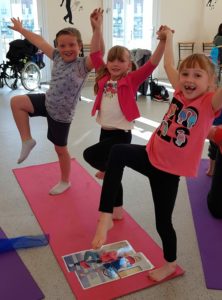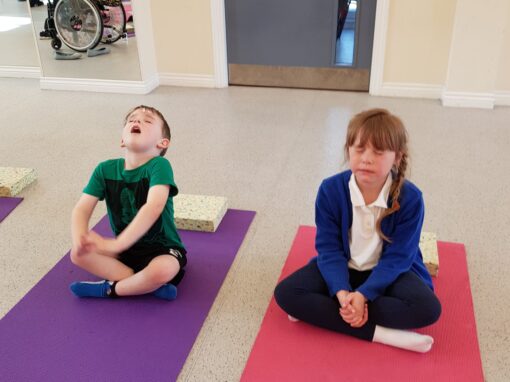Yoga and autism
Yoga is fast becoming a popular complementary therapy for children with special needs and autism. Benefits that are typically associated with Children doing yoga include—improved strength and flexibility, and an increasing sense of peace. What makes children’s yoga extra special for Autistic children is that they can experience a reduction of pain, anxiety, aggression, obsessive behaviours, and self-stimulatory activities. Children’s Yoga helps to regulate emotions and because of this children find it easier to make new friendships and have more of an understanding of emotional behaviours.

What is Autism
Autism Spectrum Disorders (ASD) affect the ways in which children communicate and interact with others, and experiences within the world around them. Children with ASD can also experience co-occurring difficulties with anxiety. Children with autism have very different sensory experiences from others, and these responses often cause their bodies to get stuck in fight, flight, or freeze modes that divert blood from the digestive organs to the skeletal muscles. This activity results in disrupted digestion, increased heart rate, and shallower breathing—all of which readily provoke anxiety.

How childrens yoga can help Autism
Children’s yoga has been shown to improve anxiety whilst reduce impulsive, obsessive, aggressive and self-stimulatory behaviour too. The breathing within a kalma session can help regulate heart rates and postures help increase strength, balance, coordination and flexibility. Furthermore children’s yoga has huge benefits on a child’s social-emotional skills, language and communication, body awareness, self-regulation, focus and concentration. Here’s our top 5 benefits kalma children’s yoga has for children with Autism:
1. Increase communication skills: Children’s yoga has been known to help cognitive skills and communication. An improvement in eye contact, sitting tolerance, non-verbal communication and receptive communication skills are all seen with children’s yoga. In a typical kalma children’s yoga session postures and breathing is used throughout, and children will learn the poses and breathing through imitating the actions of our teachers. Visual aids are used to keep reputation within a session along with guided imagery.
2. Emotional expression: Children’s yoga brings much more awareness to social cues such as facial expressions, actions and social behaviours. With this is the encouragement to children to be more aware of their emotions and how they are feeling during a session. Autistic children often have difficulty with expressive and receptive communication, they may act out their emotions in unexpected ways. Breathing techniques within a kalma children’s yoga class can be taught to children with Autism in order to release difficult or uncomfortable emotions such as anger, frustration or anxiety in more healthy ways. We feel this helps children feel ok with these emotions and that they’re able to express them.
3. Helps anxiety: Autism can significantly affect sleep, mood, behaviour and health. Due to difficulty with communication, sensory integration deficits and a variety of other challenges, children with Autism can be in a constant state of anxiousness. This state of anxiousness if often referred to as the fight/flight mode as we mentioned earlier. When children are in the fight/flight mode, cognition and communication goes down and they tend to move into chest breathing or hyperventilation, which can exacerbate their anxiety. Breathing techniques within our children’s yoga classes help to reduce anxiety and soothe the nervous system. Practicing mindful breathing, guided imagery and postures that calm the nervous system can support autistic children in developing coping skills, self-regulation skills and more effective responses to stress, both emotionally and physically. Calming their nervous systems and releasing tension in their minds and bodies supports better sleep, digestion, mood, behaviour and overall health and well-being.
4. Helps challenging behaviour: Because of the many difficulties children with ASD face in areas of language and communication, expression of emotions, sustaining attention and sensory integration, they may display challenging behaviours. A good mix of breathing techniques and yoga postures within a typical kalma class can support children with ASD not only in reducing anxiety, which can directly impact mood and behaviour, but can also support children with ASD in developing self-regulation and coping skills.
5. Creates positive self esteem: Ee feel perhaps one of the most important which children’s yoga can offer is to also support children with ASD in developing self-confidence and self-esteem. Balancing poses and standing poses in particular are exciting and powerful poses for children with ASD to practice. Whether it’s a standing, balancing or seated pose, any pose can be modified to support the ability of the child in order to build up the child’s self-esteem and help the child feel successful.
For more information on Autism visit, https://www.autism.org.uk.

